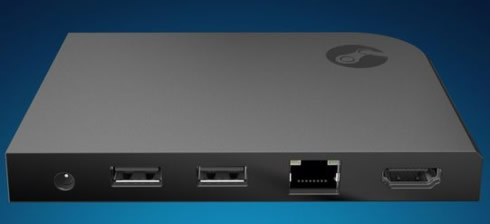
Valve Reveals Steam Link Box For Steam In-home Game Streaming
Valve on Tuesday announced Steam Link, a streaming solution that allows you to stream all your Steam content from any PC or Steam Machine on the same home network. Launching in November for just $50, the Steam Link will support 1080p, 60Hz streaming "with low latency," according to Valve.

For an additional $50 you can purchase a Steam Controller.
There are also more traditional Steam Machines being showed at GDC this week, including devices from Alienware, Falcon Northwest Syber and Zotac.
Steam Machines, Windows PCs, Macs, and Linux PCs will be able to take advantage of a Steam Link.
"We continue to see very strong growth in PC Gaming, with Steam growing 50% in the last 12 months," said Gabe Newell, Valve's president. "With these announcements we hope that we are helping build on that momentum."
SYBER, a new division of CyberPowerPC, will start offering powerful machines with customisation options, with prices to start from $449.
The three initial systems include the Syber Steam Machine-E, an entry level machine which will combine a quad-core AMD CPU and an Nvidia GeForce GTX graphics chip. At the mid level the Syber Steam Machine-P pairs the Intel G3258 3.2GHz processor and AMD Radeon R9 270X graphics, for $549. Its top tier model, the Syber Steam Machine-K, is powered by an Intel Core i5-4690K and NVIDIA GeForce GTX 970 with a price tag of $999.
Additionally SYBER will introduce the Steam Machine-Mini, the Steam Machine-Mercury prototype, and a Steam Machine-Switch concept at GDC. These six machines, expected to be ready for November.

The ZOTAC Steam Machine SN970 is powered by NVIDIA graphics and technology powering the unit, supporting up to 4 displays connected simultaneously. NVIDIA Surround and Steam Big Picture bring the experience to users on the big screen. All the next generation technologies are fully employed - including VXGI, MFAA and DSR - and take full advantage of the in-game sceneries.
Each unit comes with a Steam controller and storage also comes included in the form of a 64GB M.2 SSD and a 2.5" 1TB HDD. The device is also equipped with 802.11ac wireless.

Pre-loaded with the ZOTAC Steam Machine, the unit will boot up the OS when it is powered on for the first time, saving gaming time. Some of the features brought by the SteamOS are in-home streaming, multimedia playback, and library sharing capabilities.
During GDC, Valve also show a virtual reality (VR) headset. Developer versions of the headset will be available this spring, and partner HTC will ship their Vive headset to consumers by the end of the year.
Two new technologies are part of the VR release - a room scale tracking system codenamed Lighthouse, and a VR input system. "In order to have a high quality VR experience, you need high resolution, high speed tracking," said Valve's Alan Yates. "Lighthouse gives us the ability to do this for an arbitrary number of targets at a low enough BOM cost that it can be incorporated into TVs, monitors, headsets, input devices, or mobile devices." Valve intends to make Lighthouse freely available to any hardware manufacturers interested in the technology.
"Now that we have Lighthouse, we have an important piece of the puzzle for tackling VR input devices," said Valve's Joe Ludwig. "The work on the Steam Controller gave us the base to build upon, so now we have touch and motion as integrated parts of the PC gaming experience."
VR demos being shown at GDC include work from Bossa Studios, Cloudhead Games, Dovetail Games, Fireproof Studios, Google, Owlchemylabs, Skillman & Hackett, Steel Wool Games, Vertigo Games, and Wevr.
Valve next-gen Source 2 engine is free
After months of speculation, Valve has officially announced Source 2 Engine, the second iteration of the engine that’s powered all the studio’s games since 2004’s Counter-Strike: Source and Half-Life 2. The company will offer the new engine for free to use.
“We will be making Source 2 available for free to content developers. This combined with recent announcements by Epic and Unity will help continue the PC’s dominance as the premiere content authoring platform,” said Valve’s Jay Stelly in a statement.
“Given how important user generated content is becoming, Source 2 is designed not for just the professional developer, but enabling gamers themselves to participate in the creation and development of their favorite games,” he continued.
Valve will also release a Vulkan-compatible version of Source 2 in its continual efforts to divest itself of Windows. Vulkan was announced earlier this week and is a more powerful OpenGL successor designed to compete with Microsoft’s DirectX 12.





















